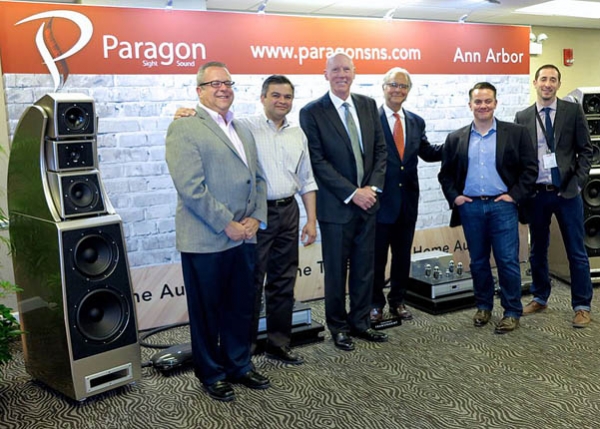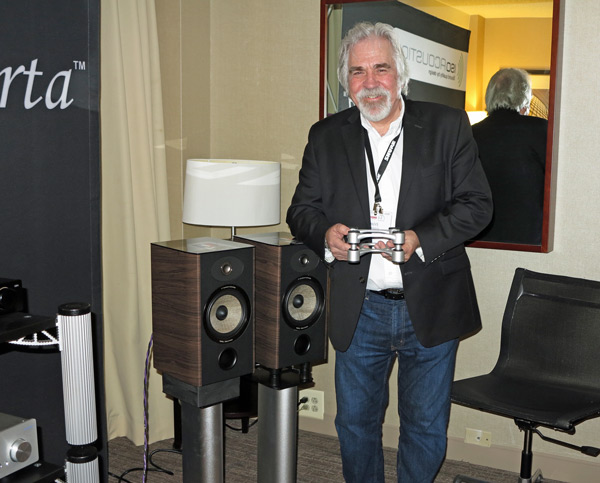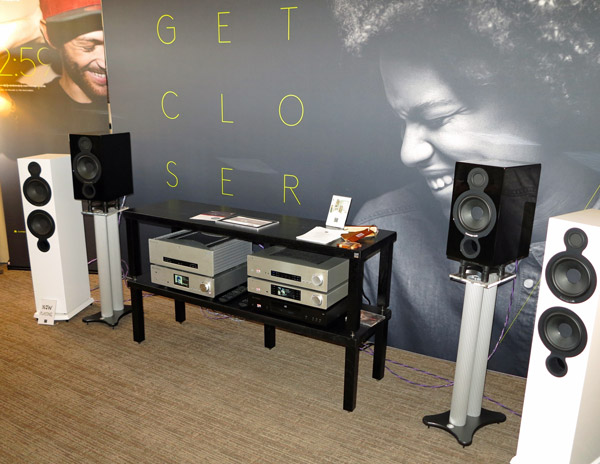| Columns Retired Columns & Blogs |
It is just wonderful to see how many great companies are responding to AXPONA. Thanks to everyone who is supporting the show and our industry. AND let's not forget the music.

At an after-hours press listening session sponsored by Paragon Audio/Video of Michigan, Dave Wilson was in a major upbeat mood for the show premiere of Wilson Audio's new Alexx loudspeaker ($109,000/pair). Not only was he overjoyed at his 50 years of marriage, but he also was extremely proud of his son, Daryl Wilson, who designed both Alexx and the Sabrina, the latter featured on the cover of the May issue of Stereophile. Noting that Daryl has been his listening buddy since he was a "little kid," he said that his son had been working on Alexx during the day as Daddy Dave worked on the forthcoming WAMM at night. He also stated that, in the not too distant future, he will say, "Daryl, it's time," and turn over leadership of Wilson Audio to Daryl.

The Alexx, Wilson's successor to the MAXX 3, acquitted itself admirably through the Doshi Audio 3.0 line stage, 3.0 phono stage, and 3.0 tape stage ($16,999/each), as well as their Jhor mono amplifiers ($29,995/pair); dCS Vivaldi digital system ($115,000 total); Transparent Opus cabling and power conditioning ($208,360 total) along with an extra-long version of John Marks' Esperanto Audio Small-Batch S/PDIF cable on Peter McGrath's Sound devices portable digital. The system sounded glorious playing an SACD of Stravinsky's L'Histoire du Soldat—a favorite of Peter McGrath for displaying bright contrasting colors and dynamic contrasts, which the Wilson/dCS combo excels in conveying—and McGrath's private recent hi-rez recording of an unnamed, internationally renowned pianist playing Chopin. Bass was less than totally tight, however, on Muddy Waters' "Hello Little Schoolgirl," sourced from a 15 ips tape played on a Studer A807 system ($115,000).
In response to a question about what size room Alexx is best suited to, Dave noted that Alexx can be adjusted for close-in listening in modestly sized rooms. For more on my reactions to Alexx, paired with different components, please click here.

A totally convincing joint demo from Shunyata Research and Stillpoints took advantage of of Exemplar Audio's XL-III single driver/crossover-less, 95dB-sensitive, minimalist-design loudspeaker ($8995/pair) to highlight the difference a change of cable or equipment support can make. Paired with Exemplar's Expo T105d tubed multi-player/DAC/music server-an Exemplar-modified Oppo ($5000), Exception 50Wpc hybrid integrated amplifier ($5500), and Seagate HD ($99), Shunyata debuted its new Hydra Denali power condition ($4995), which takes advantage of filters the company developed for use in heart surgery clinics worldwide.
Shunyata's Grant Samuelson attached a stock power cord to the Denali, which he in turn plugged into the company's Venom PS-8 power strip ($595), and played Elisabeth Shepherd's "Buzzard Song." Then he switched to Shunyata's Alpha High-Current power cord ($1250), and began the track anew. The difference in color was huge, and as apparent as the lower noise floor and greater liquidity. Then Bruce Jacobs did a 180° turn by removing the Stillpoints Ultra 6 isolation feet ($939/each) from the integrated amp, which sat upon a Quadraspire rack. Immediately, the music sounded leaden and lethargic, as though someone had slipped a downer into the signal path.
John Tucker of Exemplar informed me that Winston Ma of FIM Recordings is currently in hospice, in the final stages of brain cancer. John, who produced the last five FIM discs, let me a hear a snippet of FIM's not-yet-finished final recording, which will serve as a tribute to Ma's years of service to the audiophile community. May he depart in peace, surrounded by angels playing the music he loved dearly.

LampizatOr's system delivered a little brightness on top—it could easily have been room-related—balanced with a laudably neutral midrange. When all was said and done, the sound was warm and gorgeous. As best I can decipher the exhibitor's scrawl in my notebook—mine is just as bad—we heard LampizatOr's single-ended Golden Gate with remote volume control ($15,000), Komputer DSD transport ($5500), and Silk power conditioner ($2300); Vapor Sound Derecho loudspeakers ($8900/pair), and Verastarr cabling.

The joint recipient of my 3rd floor Budget System Award goes to April Music for the pairing of their new, Korean-made Aura Spirit 150Wpc integrated amplifier/receiver with AM/FM tuner and headphone output ($1950) and Aura Spirit Vivid CD player ($1000). Thanks in no small part to Verastarr cabling and Dynaudio's much-lauded Confidence C1 Platinum loudspeakers ($8750/pair) on C6 stands, the sound was warm, glowing, and fully satisfying.
The April Music Aura Note V2 all-in-one 125wpc High-End receiver ($2500), which has a different power supply and was reviewed by Art Dudley in our April issue, may not produce sound as full, detailed, and dynamic, but it still made lovely music—that's music, not just sound—on classical vocals with piano, classical orchestral, and smooth jazz. A grateful thumbs up to April Music for its choice of components and fine music.

"Those look a lot like the stands Dynaudio sells for use under bookshelf loudspeakers, I said to Dave Morrison of IsoAcoustics. "They make a real difference in sound under the Dynaudios on my desktop."
The similarity is hardly coincidental, because IsoAcoustics makes Dynaudio's speaker stands. To demonstrate the effectiveness of IsoAcoustics Aperta stands, Dave switched between two identical bookshelf speakers, one on a wooden block, the other on an adjustable IsoAcoustics Aperta stand whose design is a bit different than the stands for Dynaudio. The Aperta cleaned up the spread in the lower midrange, muffled background, and unfocused bass heard with the wooden block. The company's website includes an online calculator for determining which modular aluminum speaker stand is best for you.

Eat your heart out, Art Dudley, because I got to hear cellist Vincent Bélanger's live Audio Note demo this time around. Bélanger, whose patience with questions suggests he is just baby steps away from achieving true Christ Consciousness in this lifetime, supplied the third track to two that were coming independently from the left and right pair of Audio Note UK's forthcoming AZ Two D, rear-loaded, quasi-parabolic horn loudspeakers (approx. $3500/pair). Between them sat the North American show debut of AN UK's prototype Cobra 25Wpc, EL34, push-pull integrated amp/DAC with wireless remote ($3500) and prototype TT Three 3-point suspended turntable with outboard electronic power ($8000). The latter used an AN Arm Three ($2000) and IQ3 MM cartridge ($975). Both the Cobra and TT Three are expected in September. An AN R Zero RIAA phono preamp ($1750) was also in the chain. I can't pretend that the system wasn't distorting in order to match Bélanger's volume, but it was a lovely and gratefully received experience nonetheless.

I was initially puzzled by all the laid back people happily yapping away over the music in Cambridge Audio's room until I saw all the cups filled with beer and wine, and was told, "Our audio is meant to fit into people's lifestyles" (which obviously include alcohol). "Cambridge Audio wants to be how people start out in hi-fi." I can vouch more for the smiles than the sound, which variously came from Aeromax 2 stand-mount loudspeakers ($699/pair) Aeromax 6 floorstanders ($1400/pair), CXN network player ($1099), CXA80 integrated amplifier ($999), CXC CD transport ($499), 851N flagship network player ($1799), and 851W flagship power amp ($2500).
I look forward to the day when Cambridge Audio can dispense marijuana nibbles instead. Hint: Host a demo in Washington State, where I live.

I've given the wonderful Doug White of Pennsylvania dealer The Voice That Is a hard time at the last two shows, but this time, his Tidal system met all expectations. Playing the time honored 1998 Reference Recordings version of Saint-Saëns' Danse Macabre that has proven a classical fallback at shows ever since its release on Mephisto & Co., the system produced beautiful timbres, gorgeous warmth, and liquidity for days. There may have been a bit of bass booming—how could there not have been, given the size of the speakers vs a small, virtually square hotel room?—and distortion that quieted down when Doug stopped driving the volume past what the room could handle, but the way the triangle hung in space confirmed the system as top flight.
The Tidal/Bricasti/Aurender/Purist system also excelled in playing a large-voiced operatic soprano without getting harsh and bright. I couldn't believe it when Doug next turned to another cliché, Chris Jones' "No Sanctuary Here," but when I heard the individual background voices emerge distinctly from what always has sounded on previous occasions like a congealed, rumbling mass, I could totally appreciate how good this system was. Ditto for some thankfully not overplayed and gratefully received Lee Ritenour. Heard: North American premiere of Tidal's Presencio preamplifier ($77,990) and Impulse monoblock amplifiers ($64,990), world premiere Tidal Audio cables, and Tidal Agoria loudspeakers ($109,000/pair in midnight gloss black); Bricasti Design M1 SP DAC ($9995), Aurender W20 Reference music server ($17,600), Purist Audio Design 25th Anniversary cabling, Dynamic Design power cords, Silver Circle Audio TCHAIK 6 power conditioner, and StillPoints Ultra SS, 5, and 6 supports and Aperture panels.

Audio Plus Services featured a fabulous looking system that paired Focal Sopra 2 loudspeakers ($13,999/pair) supported by IsoAcoustics Pucks ($1000/set of 8) with Micromega M1 100 100Wpc class-A/B integrated amp/DAC/streamer ($1999) and Crystal Cable cabling. I would have liked a bit more space and air between instruments, but the sound was otherwise very, very nice.

It is just wonderful to see how many great companies are responding to AXPONA. Thanks to everyone who is supporting the show and our industry. AND let's not forget the music.

The Amp was a Musical Design T-100 Elite for $2995 and there was a new invention from Essence called the Chimera that filters back EMF, Eddy currents, and realigns electrons with carbon nanotube technology. $2700 for a set.

Thanks for the additional information, Duane. Next show, please have sheets with equipment and prices available for the press. It really helps.